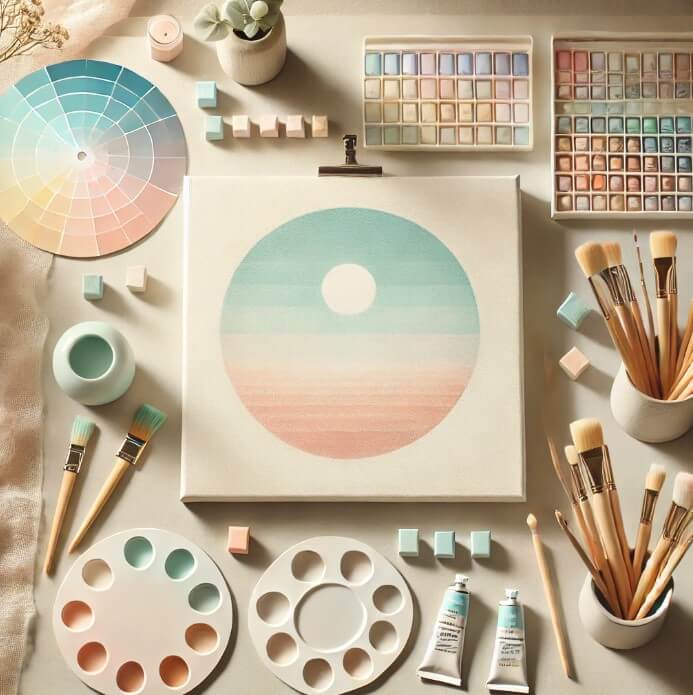Making the right choice of a pastel color palette ideally compliments the painting and achieves the desired effect intended by an artist. Pastel hues due to their pale, dusky and light characteristics can instantly give an artwork such as a painting a gentle, tender or cheeky aura. Therefore, this guide will be ideal for learning how to select pastel color palette for painting.
What Are Pastel Colors?

Typically pastel colors are defined by low intensity and high brightness textures, created by mixing different colored paints with white. Pastel colors are great for fashion, painting, or interior design items as they definitely create a soft and gentle atmosphere.
• Examples of Pastel Colors:
- Baby Blue
- Blush Pink
- Lavender
- Mint Green
- Peach
These shades are products of nature. Animals and plants showcase these color palettes vividly during activities like wool washing. Sunset blooming is also an excellent idea to get inspired by while trying to design your palette. Balance is achieved by pang of color theory in its primary form, which is the idea of mixing tones.
Steps to Select a Pastel Color Palette

Define the Mood or Theme
The theme of your artwork dictates the colors you should choose. For instance:
• Romantic Theme: Use pastel pinks and peaches.
• Nature-Inspired: Select pastel greens and blues.
• Playful Vibes: Incorporate mint green, lemon yellow, and lavender.
Choose a Base Color
Select a dominant pastel color that sets the tone for your painting. This base color will guide the rest of your palette. For example:
• In a floral painting, pastel pink can be the base.
Balance Colors with the Color Wheel
Use the color wheel to create harmony:
• Complementary Colors: Pair opposites like pastel blue and soft peach.
• Analogous Colors: Combine adjacent tones, such as lavender, pastel pink, and mint green.
• Triadic Colors: Use three evenly spaced pastel shades like mint green, soft yellow, and baby blue.
Key Techniques for Working with Pastel Colors
Adjust Lightness and Saturation
Pastel colors are naturally light, but you can refine their appearance:
• Watercolor: Add more water for a soft pastel effect.
• Acrylic or Oil Paints: Mix white to mute the color’s intensity.
Use of Neutral Tones
Light beige or gray colors are classified as neutral colors and can be an improvement to the pastel colors. They give a general equilibrium to the colors and stop the color palette feeling too strong.
Practical Tips for Painting with Pastels
Limit Your Palette
Using too many colors can make your painting feel cluttered. Stick to 3–5 complementary or analogous tones.
Test Your Palette
Before starting your artwork, create small swatches to test how the colors interact. This helps you adjust shades if needed.
Draw Inspiration from Nature
Look at natural elements like soft petals, skies, or landscapes to find organic pastel combinations. The delicate hues often found in springtime can be particularly inspiring.
Example of a Pastel Color Palette
| Color | Hex Code | Description |
|---|---|---|
| Blush Pink | #FADADD | Soft, romantic pink |
| Mint Green | #98FF98 | Fresh, calming green |
| Baby Blue | #A2CFFE | Gentle, serene blue |
| Lavender | #E6E6FA | Delicate, dreamy purple |
| Peach | #FFE5B4 | Warm, cheerful peach |
FAQs
How do I create pastel colors?
Pastel shades are created by mixing vibrant colors with white or by diluting pigments in mediums like water or oil.
What is the best medium for pastel colors?
Watercolor and acrylic are popular mediums, but oils can also produce beautiful pastel tones when blended with white.
Can I mix pastels with bold colors?
Yes, but use bold colors sparingly to maintain balance. Pastels work well as the primary tones, with bold accents for contrast.
Why do pastels work well in art?
Their soft and soothing qualities make them versatile for evoking emotions like calmness, nostalgia, or joy.
How can I ensure a harmonious pastel palette?
Use a limited number of colors and follow principles of balance, such as combining complementary or analogous tones.
Conclusion
Mastering how to select pastel color palette for painting requires an understanding of color theory, mood setting, and balance. Whether you’re inspired by nature, experimenting with mediums, or simply exploring a serene aesthetic, pastels offer endless possibilities. Start small, test combinations, and let your creativity guide you toward crafting beautiful, harmonious artworks.
Visit Thinkow for more topics.


